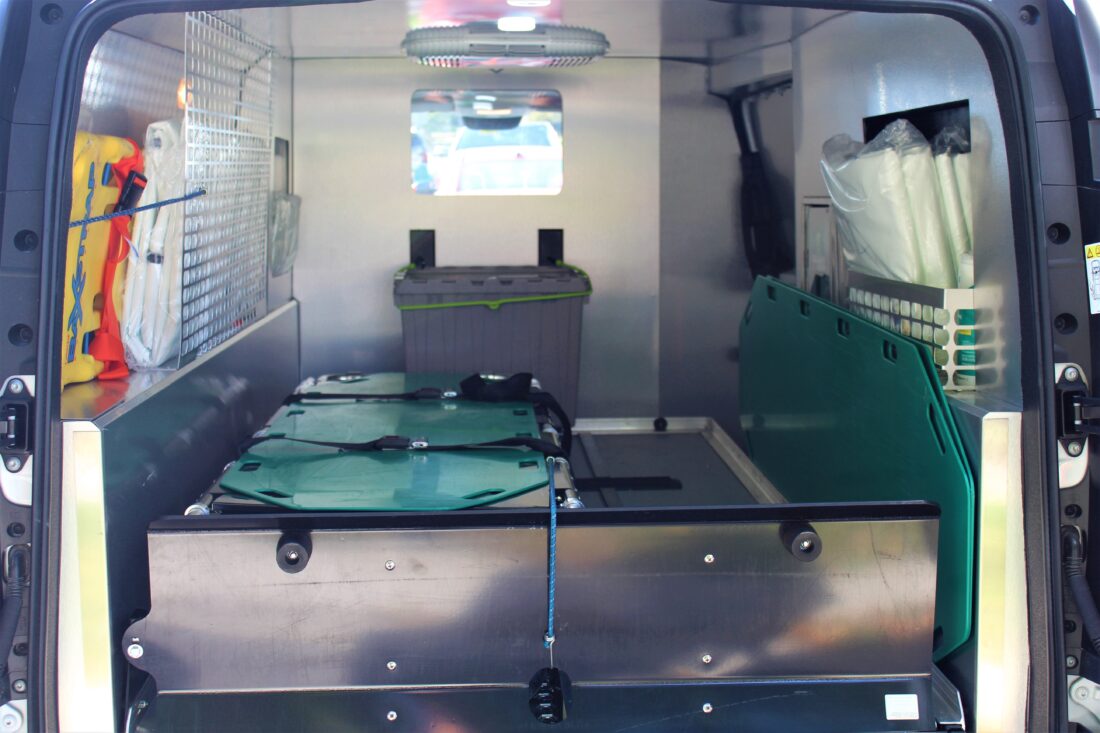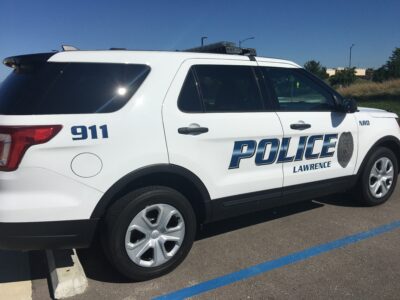For coroner scene investigators, the job is about the living as much as the dead

photo by: Chris Conde/Journal-World
Coroner Scene Investigators William Hallagin, left, Joni Kisslinger, center, and Rob Kort, right, stand in front of the county's new transport van on Oct. 5, 2022, at the Judicial and Law Enforcement Center.
The dead come in many shapes and sizes, but one thing many of them have in common is they leave behind family and friends. For William Hallagin, Douglas County’s lead coroner scene investigator, his job is all about the living.
“I always told people that I helped more people as a coroner investigator than I ever did as a paramedic, because I’m able to help them in a time and moment of confusion where they don’t know what’s going on,” he said. “They’re lost, they’re stressed and grieving, and I kind of help turn them in the right direction and take those first couple steps in the grieving process.”
Hallagin recruited a new team of coroner scene investigators (CSI) for the Douglas County Sheriff’s Office in September to take over investigating unattended death scenes from Lawrence Douglas County Fire and Medical after a 2021 study showed that CSI work was directly impacting the availability of emergency medical services within the county.
The study was conducted by the Wichita State University Public Policy & Management Center with assistance from LDCFM after a joint request from the City of Lawrence and Douglas County to review EMS and Fire services in the area. LDCFM responded to 240 deaths in 2019 and CSIs investigated 189 of them with an average of two hours per investigation.
“One of the nice things about the change from Fire and Medical to this, since I’ve been able to see both of them, is our Fire and Medical crews are focused and concentrating on medical, fires, rescue, public education, and training and all that. In this position, we’re able to focus on our in-depth investigations. We’re able to focus on making sure that we’re always getting the best investigation we can. We’re not being hurried off of a scene because all the ambulances in town are busy and they need another ambulance. I think to the citizens in the community, that’s a huge benefit,” Hallagin said.
While the CSI team is new, Hallagin is heading into his 13th year conducting death scene investigations. He recently retired from LDCFM as a lieutenant paramedic after 21 years of service, with the last 12 years serving as both a paramedic and a CSI.
“I was a lieutenant paramedic and I continued those duties. The CSI was a subset of those duties. So, I spent my days in an ambulance and then whenever somebody would pass away, I would kind of change hats and go do a coroner investigation,” Hallagin said.
The work that CSIs do is anything but glamorous, and the specifics of scenes and investigations isn’t something Hallagin said he can openly talk about since you never know who someone might be related to or if someone might be grieving privately. He said he has investigated more than 2,000 deaths in the county.

photo by: Contributed
Coroner Scene Investigators Rob Kort, left, and William Halligan, train with a medical dummy.
“I don’t like to sugarcoat it during (job) interviews because I don’t want somebody to come in and thinking ‘oh, this is all TV glamor and we’re gonna do this and that and never have a challenging day or challenging moment’ because that would be unfair to them and get somebody into something that they don’t want to be involved with,” Hallagin said.
The team consists of seven members led by Halligan. Out of the other six, only one has any experience investigating death scenes, though all of them come from a medical field. The other members include a retired paramedic, two registered nurses, a microbiologist, a trained forensic investigator and an EMT. The CSI unit is required to have two people on call 24/7, Hallagin said.
“We’ve got a pretty diverse group with a lot of different experiences and knowledge that we’re able to share,” Hallagin said.
One of the issues LDCFM noted in its report when it was in the process of handing off the duties of death scene investigations is that it was difficult to recruit people for the job. Emergency crews are dedicated to saving lives and rescuing people and while death may be part of the job it isn’t the focus, Hallagin said.
“As a paramedic, you’re always helping people. That’s kind of what drives you. I found that as a coroner investigator, there was a niche that wasn’t being filled by people that didn’t understand death and how it occurs,” Hallagin said.
To avoid any interruption of service the new recruits are currently receiving on the job training until the next bi-annual course with the American Board of Medicolegal Death Investigators. The new CSIs will be fully trained and certified after taking classes in January at St. Louis University in Missouri, Hallagin said.
“We try to spend a little bit of time every month bringing people in to do simulated training. We can’t dictate what types of scenes we have. We can’t dictate if we have cardiac arrests or falls or homicides or motor vehicle accidents. So we’re able to set up some different scenarios and train on things you need to look at, things you have to get pictures of, or these are things that are important, without actually having to be on an active scene. So that whenever we do have the active scene, they all have kind of an idea what they’re looking for,” Hallagin said.
On the scene alongside law enforcement, CSIs may identify important aspects of the death that law enforcement investigators might not. If a death scene is not yet a crime scene, a CSI might find something that changes it from an unattended death into a crime scene, Hallagin said.
The investigations conducted by the CSIs have always been independent from those conducted by law enforcement which is one aspect of the new team that Sheriff Jay Armbrister said is important to maintain now that it is being administered by the sheriff’s office.
“They conduct their own investigation, away from the criminal detectives and from the prosecutors. They do their own thing. We’ve always really liked and respected the fact that these folks were medical personnel coming in and looking at a scene that we were looking at from a criminal aspect. We wanted it to remain autonomous and independent of any other investigation. So, even if there’s a dead body in the county, we send our detectives to go out and investigate and then we’ll send these folks out and investigate as well, ” Armbrister said.
Armbrister said the expense of building the new team wasn’t small and required buying new equipment and hiring the staff to do the work. He said the office had to purchase a new transport van and plans to buy a second as well as a large cooler to house bodies that are waiting to be transported to the coroner’s office, Forensic Medical, in Kansas City, Kansas.
“The equipment (cost) was substantial. Just because we were starting from ground zero. We’ve purchased a new van we’re trying to find a second one. We’re doing all the transports now. We used to have contracted the transports through a local funeral home but we’re getting away from that contract and just reinvesting that money into our program,” Armbrister said.
As previously reported by the Journal-World, funds for the CSI unit were set aside in the 2022 budget with an estimated startup cost of $140,760 and an ongoing annual cost of $225,164. The budget called for $80,000 for two coroner transport vans and $16,000 for the cooler.
Hallagin said the new transport van is designed to carry one body at a time but has an additional cot that, if necessary, can carry two people. The van has an independent air control system for the bodies in the back that insulates the driver’s cab from smells that may come off of the deceased. He said the cooler is designed for three bodies.

photo by: Chris Conde/ Journal-World
A view into the back of the Douglas County Coroner Investigations Unit transport van.
“It’s a big silver box with a door on the front that’s 6 feet tall, 4 feet wide, and 10 feet long. It does have limitations. We found out the other day that when people get to a certain size, they don’t fit in the cooler very well,” Halligan said.
The CSIs rely on the van and the cooler for transportation and storage but the key equipment used in their investigations are inexpensive and timeless.
“Always a clipboard to take notes on everything, and a camera to take pictures of the scene, because occasionally there are things that will play into what caused them to be dead that will help the coroner have a better picture of what’s going on,” Halligan said.

photo by: Contributed
Coroner Scene Investigator, Livia Palmieri, practices her photography skills on a medical dummy.
Beyond the equipment, the costs, and the training, are the people doing the work and people affected by the death of a loved one.
“People lose what medical examiners and coroners do in the TV perception of that. That we’re cold-hearted individuals that are simply interested in snatching bodies and cutting them up. That’s not the case. Everybody on my team, we’re all humans, we have the same emotions that everybody else does. Challenging scenes can be challenging for all of us. I try to coach and let my people know that empathy and emotions on scene is not a bad thing. That way, the families know that we’re human too but we have to be able to walk with that and still do our job. Our job is to get the answers as to why somebody’s passed away,” Hallagin said.
Ushering the dead into a van, taking pictures and notes, connecting with law enforcement and the coroner are all crucial to the job but guiding the living through the first moments of grief and loss is the part of the job where Hallagin said he helps the most.
“People always say it gets better. I don’t tell people that. Everybody grieves in their own ways. I try to express to people that how they grieve is how they grieve. Don’t let somebody else tell you how to grieve. You have to go through the process yourself. It’s a very individual, sometimes public, sometimes a private process. You have to go through your own steps in your own way. If you don’t, then it comes back and haunts you. You live with grief, but you don’t ever get over it. Sometimes it’s behind (you) and then it jumps back out. That’s why I try to relate to people that this is not a normal process. It’s how you deal with it, how you move through it. It’s not how TV or a friend or whoever tells you that you have to cry, you have to manage, you have to accept it. It’s not that cut and dry,” Hallagin said.







